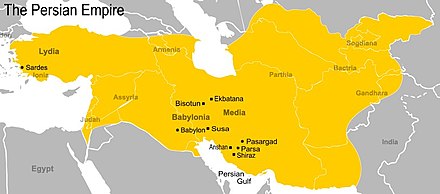Šamaš-aba-usur
Šamaš-aba-usur ( late Babylonian Shamasch-aba-usur, Samas-aba-usur ; Biblical Scheschbazzar , Hebrew Šešbassar, Scheschbassar ) clad in the 6th century BC. As a Babylonian official under Cyrus II the office of the Persian commissioner for central affairs . From a conservative point of view, the equation with Zerubbabel remains controversial .
Life
Functions and position
Further details about his life are not known. Documents are stored in the archives of the Persian city administration in Ekbatana , among others the correspondence of the governor Tattenai with the chancellery of Darius I in Susa from the year 518 BC. Was located. Šamaš-aba-usur is mentioned regarding the mission of Tattenai in connection with the reconstruction of the Jewish temple in Jerusalem . Tattenai told Darius I. with that he had made an inspection tour to Jerusalem at the spot to learn about the local temple reconstruction. At the meeting, the Jewish Council of Elders referred to the 539 BC Cyrus edict proclaimed . In this administrative matter, Šamaš-aba-usur assumed the role of the official who had previously worked for Cyrus II with regard to the Jewish temple treasures .
Mention of the Šamaš-aba-usur in the Old Testament
In the book of Ezra , Šamaš-aba-usur is mentioned as Sheshbazzar:
“The golden and silver utensils of the house of God, which Nebuchadnezzar II had taken from the temple in Jerusalem and brought to the temple in Babylon, gave Cyrus II from the temple of Babylon to Sheschbazzar, whom he had installed as Peha . The Sheschbazzar was ordered by Cyrus II: Take these utensils, go and place them in the temple in Jerusalem; and the house of God is to be rebuilt in its place. Then that Sheshbazzar came and laid the foundations of the house of God in Jerusalem; and since then until now it has been built, but it is not yet finished. "
Historical reference to the Old Testament
The foundation stone of the temple in Jerusalem was not laid by Šamaš-aba-usur, but only 18 years later under Zerubbabel . The Jewish council of elders tried to convince the governor Tattenai that Cyrus II had ordered the building of the temple and that the restoration had therefore begun. The chronicler of the Hebrew proclamation of the Ezra book had used the information from chapters 5: 14-16 for his own interpretation and gave Šamaš-aba-usur the title Prince of Judah (Hebrew: hannasi-lihuda ) and the return of the exiles was anachronistic in the year 538 BC Moved back. A designation of Šamaš-aba-usur as Prince of Judah is in contrast to the titulatures of the time and is therefore considered refuted.
The actual departure of the exiles took place in the twenties of the 6th century BC. At the earliest under Cambyses II ; More likely, however, the homecoming under Dareios I can be assumed, since the prophets Zechariah and Haggai did not appear until 520 BC. Called for the rebuilding of the temple. With this additional mention, Šamaš-aba-usur is definitely ruled out as a client.
literature
- Herbert Donner : History of the people of Israel and its neighbors in basics 2, Vol. 4/2 (3rd supplemented edition) . Vandenhoeck & Ruprecht, Göttingen 2001, ISBN 3-525-51680-0 .
- Alexander Weidner: Scheschbazar . In: Michaela Bauks, Klaus Koenen, Stefan Alkier (eds.): The scientific Bibellexikon im Internet (WiBiLex), Stuttgart 2006 ff., Access date: July 4, 2019.
Notes and evidence
- ↑ Jostein Ådna : Jesus' position on the temple: the temple action and the temple word as an expression of his messianic mission. Scientific studies on the New Testament, Mohr Siebeck, Tübingen 2000, ISBN 978-3-1614-6974-9 , p. 62
- ↑ See also: Francis Ian Andersen : Who built the second Temple? Australian Biblical Review 6, 1958, pp. 1-35 and Anthony Gelston : The Foundation of the second Temple In: Vetus Testamentum 16, 1966, pp. 232-235.
| personal data | |
|---|---|
| SURNAME | Šamaš-aba-usur |
| ALTERNATIVE NAMES | Sheshbazzar |
| BRIEF DESCRIPTION | Babylonian official |
| DATE OF BIRTH | before 539 BC Chr. |
| DATE OF DEATH | 6th century BC BC or 5th century BC Chr. |
